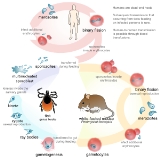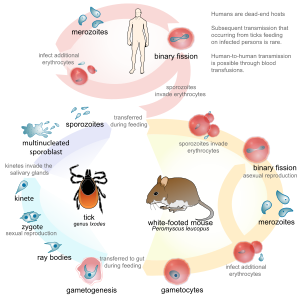
Theileria microti
Encyclopedia

Ixodes scapularis
Ixodes scapularis is commonly known as the deer tick or blacklegged tick , and in some parts of the USA as the bear tick. It is a hard-bodied tick of the eastern and northern Midwestern United States...
s. It was previously in the taxonomic
Taxonomy
Taxonomy is the science of identifying and naming species, and arranging them into a classification. The field of taxonomy, sometimes referred to as "biological taxonomy", revolves around the description and use of taxonomic units, known as taxa...
genus
Genus
In biology, a genus is a low-level taxonomic rank used in the biological classification of living and fossil organisms, which is an example of definition by genus and differentia...
Babesia
Babesia
Babesia is a protozoan parasite of the blood that causes a hemolytic disease known as Babesiosis. There are over 100 species of Babesia identified; however only a handful have been documented as pathogenic in humans....
, as Babesia microti, until ribosomal RNA
Ribosomal RNA
Ribosomal ribonucleic acid is the RNA component of the ribosome, the enzyme that is the site of protein synthesis in all living cells. Ribosomal RNA provides a mechanism for decoding mRNA into amino acids and interacts with tRNAs during translation by providing peptidyl transferase activity...
comparisons placed it in the sister genus Theileria
Theileria
Theileria is a genus of parasitic protozoan that belongs to the phylum Apicomplexa and is closely related to Plasmodium. Two Theileria species, T. annulata and T. parva, are important cattle parasites. T. annulata causes tropical theileriosis and T. parva causes East Coast fever. Theileria are...
. T. microti is responsible for the disease human theileriosis, similar to babesiosis
Babesiosis
Babesiosis is a malaria-like parasitic disease caused by infection with Babesia, a genus of protozoal piroplasms. After trypanosomes, Babesia are thought to be the second most common blood parasites of mammals and they can have a major impact on health of domestic animals in areas without severe...
, a malaria
Malaria
Malaria is a mosquito-borne infectious disease of humans and other animals caused by eukaryotic protists of the genus Plasmodium. The disease results from the multiplication of Plasmodium parasites within red blood cells, causing symptoms that typically include fever and headache, in severe cases...
-like disease which also causes fever and hemolysis
Hemolysis
Hemolysis —from the Greek meaning "blood" and meaning a "loosing", "setting free" or "releasing"—is the rupturing of erythrocytes and the release of their contents into surrounding fluid...
.
An important difference from malaria is that T. microti does not infect liver cells. Additionally, the piroplasm is spread by tick bites (Ixodes scapularis
Ixodes scapularis
Ixodes scapularis is commonly known as the deer tick or blacklegged tick , and in some parts of the USA as the bear tick. It is a hard-bodied tick of the eastern and northern Midwestern United States...
, the same tick that spreads Lyme disease
Lyme disease
Lyme disease, or Lyme borreliosis, is an emerging infectious disease caused by at least three species of bacteria belonging to the genus Borrelia. Borrelia burgdorferi sensu stricto is the main cause of Lyme disease in the United States, whereas Borrelia afzelii and Borrelia garinii cause most...
), while the malaria protozoans are spread via mosquito. Finally, under the microscope, the merozoite form of the T. microti lifecycle in red blood cells forms a cross-shaped structure, often referred to as a "Maltese cross
Maltese cross
The Maltese cross, also known as the Amalfi cross, is identified as the symbol of an order of Christian warriors known as the Knights Hospitaller or Knights of Malta and through them came to be identified with the Mediterranean island of Malta and is one of the National symbols of Malta...
", whereas malaria forms more of a diamond ring structure in red blood cells.

